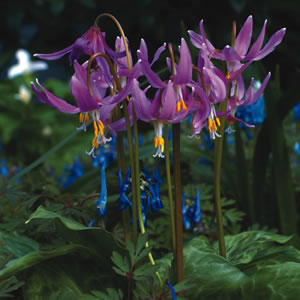Erythronium Growing Guide

What is Erythronium?
Erythronium (Erythronium tuolumnense) also known as Trout Lily, Adder’s Tongue, or Dog’s Tooth, Dog’s Tooth due to the shape and colour of the bulb, is a herbaceous perennial bulb. It is part of the Liliaceae family and is native to North America, Europe and temperate East Asia. Erythronium has decorative foliage which grows low to the ground. The foliage comes in pairs and is bright green and depending on the species can be flecked with colour such as silver, brown, maroon, purple or bronze. Erythronium flower in mid to late Spring where stems holding the down facing starry flower arises above the foliage. The flowers come in a range of colours from white, cream, soft yellow, or pink. They require a moist shaded position in humus rich well drained soil that is protected from frosts. Erythronium species are best suited to cool damp climates. They do not like humid heat, although they can cope with hot dry Summers if placed in a shaded position.
Benefits of Growing Erythronium
Erythronium does best in a woodland setting or rock garden as this represents where they are found in the wild. They grow well in clumps under deciduous trees not only for their looks but they get the shade during warm Summer days. They are also ideal for pots and containers, rockeries and waterside plantings. Most erythronium species multiply quickly and are fairly pest resistant.
How to Grow Erythronium
Climatic Zones
Cool, temperate, arid.
Plant Size
Height: 20-35cm, Width: 10cm
When To Plant Erythronium
Plant in Autumn.
Soil Preparation
They prefer a moist but well drained soil. Before planting add a bulb or complete fertiliser to the soil. Dig through some compost or well broken down animal manure.
How To Plant Erythronium
Plant in full shade and protect from frost, 20cm apart with the bulb planted 5cm below the soil surface.
Erythronium Plant Care
Regular watering is needed especially during warm to hot times. Erythronium like to remain moist even during dormant times.
Erythronium do not like to be disturbed. However most species multiply quickly and may be divided after a few years. This can be done during their dormant time (mid to late Summer).
Fairly pest resistant. Watch out for snails and slugs.







